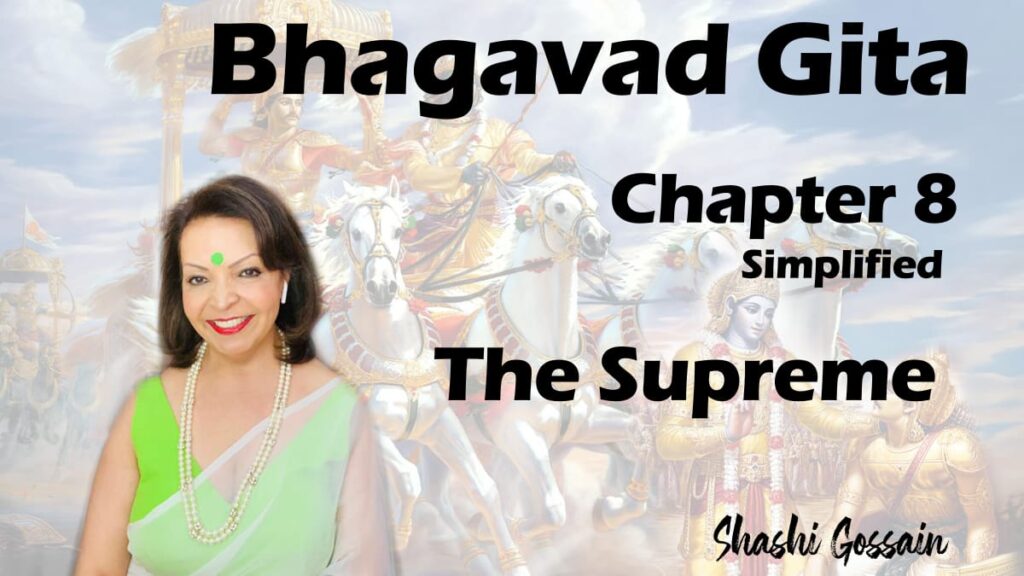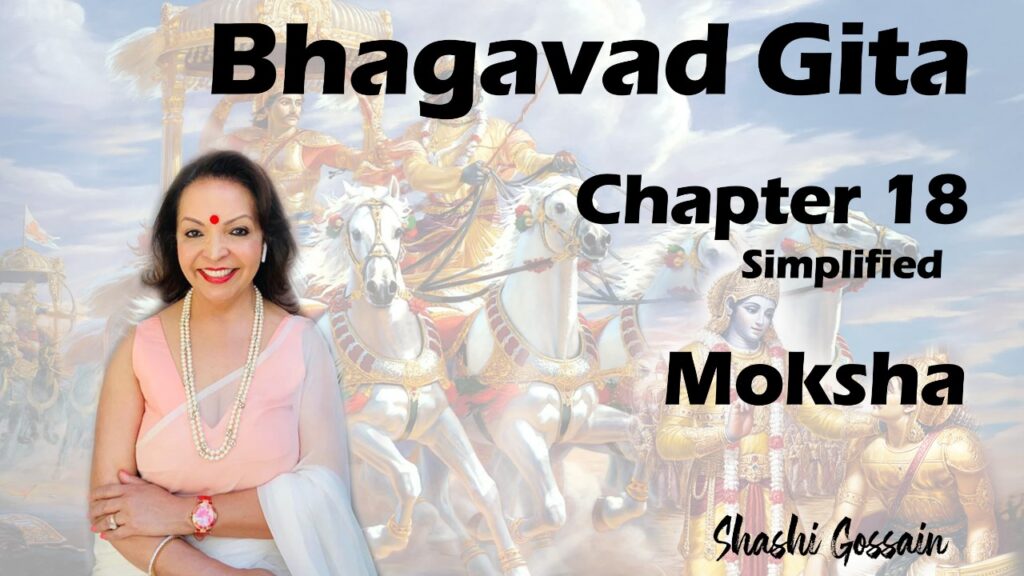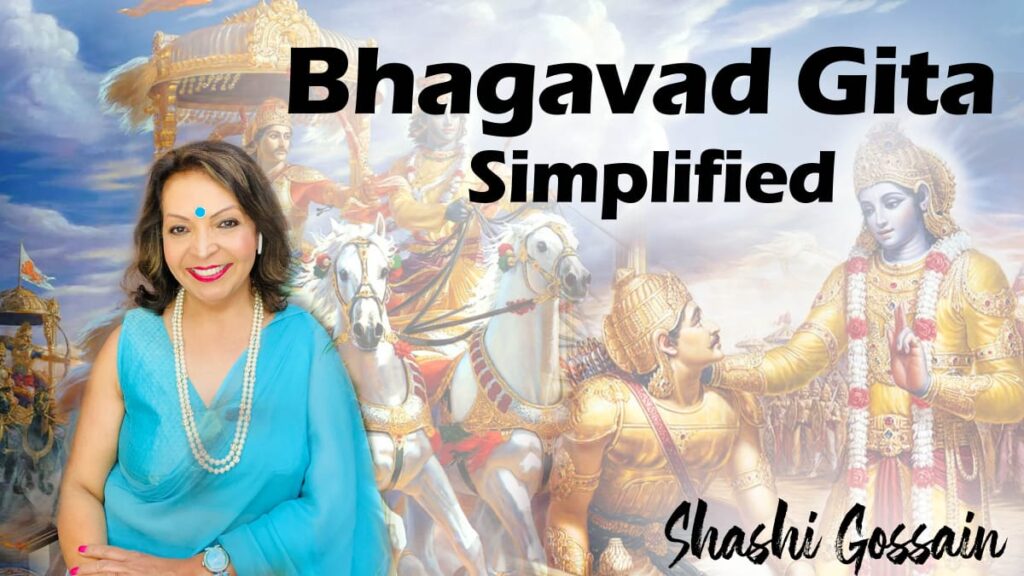In the seventh chapter of Shrimad Bhagwat Gita, Shri Krishna gave a detailed description of Ishvara, and stressed the importance of recognizing the infinite aspect of Ishvara. Eighth chapter of Shrimad Bhagwat Geeta is perhaps one of the more philosophical chapters of the Gita. It deals with the theme of life after death, something that has not been addressed so far in the Gita. Arjun starts by asking Krishnaji seven questions:
- What is Brahman? Shri Krishna answers that brahman is the imperishable, supreme eternal essence that we encountered in the second chapter.
- What is self? (adhyaatma) Shri Krishna had already explained that each person has a unique combination of sattva, rajas and tamas that makes up their personality, which covers the eternal essence within us. Adhyaatma is the eternal essence that is covered by an individual’s attributes.
- What is Karma? He says that it is the force that brings about the creation of every entity in this universe. It brings matter into an object form. Ishvara, through one single action, created the universe & matter. But our ego, our false sense of individuality, comes under the delusion that it is “I’, the doer of all actions, which takes us away from liberation. This is further divided:
- Adhibhootam: This is all the visible matter seen in the universe, which will eventually perish.
- Adhidaiva: Literally, means a “person” in the shloka. It is the intelligent principle that resides within every living and non-living object in universe.
- Adhiyagnya: this is the world of activity and relationships.
Analogy- In a movie: Brahman is the light behind a projector, without which you cannot see a movie. Adhyaatma is the spotlight on the actor Adhibhoota is the light on all the objects around the actor Adhidaiva is the creative intelligence, or the film set, decorator Karma is the mechanism of projection Adhiyagnya: is the activity and relationships between actors In the last chapter, Shri Krishna had hinted that only the one who remembers Ishvara at the time of death will attain Ishvara. So, Arjuna’s 7th question is:
How does one attain Ishvara at the time of death?
In most cases, we may not know when we die. We could die in an accident, or loose our mental faculties, or our attachment towards our family will occupy our final thoughts. Shri Krishna also states that although the thought at the time of death is not really something that we can control, but it is in fact, an outcome of our pattern of thinking throughout our lives. If we examine our thoughts over the course of our day, we will notice a great variety of thinking. For most of us it will be a mix of mostly family-related and work-related thoughts, mixed with some thoughts about spirituality. But in the background, we will always have a thought that is going on all the time. It will come to the forefront when we are alone. We can emulate the mind of a mother who, regardless of what she is doing, always thinks about her child in the background. So then, our deepest love, our deepest interest and our deepest longing will bear fruit in our next life. Having known this, what should we now do? Shri Krishna gives the ultimate teaching to all of mankind. Since the thought at the time of death determines our fate after death, and the thought of death is an outcome of our lifelong thinking, Shri Krishna instructs us to remember Ishvara at all times and perform our duties. We are not asked to give up our duties, retire to a forest and constantly think of Ishvara there. Shri Krishna wants us to first remember Ishvara, and then perform duty according to our svadharma. With this instruction, meditation takes on a whole new dimension, dedicated to Ishvara.
How can this be possible? What does upasana mean?
Our mind can only think of one thought at a time. So the way to meditate continuously is to somehow understand that everything we see, do and know is Ishvara. If, while performing any action, we know that the actor, the action, the instrument, the process and the result; everything is Ishvara; we will never forget Ishvara. By practicing meditation constantly on Ishvara, we can change our final thought to Ishvara. This constant meditation upon Ishvara is called upaasanaa.
How many types of meditation are there?
Shri Krishna described some kinds of meditation: To perform upaasana, we need the support of either name or form, since it is extremely difficult to meditate upon something that is intangible. Any deity can be meditated upon, but remember that it points to Ishvara, the supreme divine person. Krishnaji then describes the grandeur of Ishvara. Ishvara comprises the set of laws that hold the entire universe together. He calls him:
- “parama purusha”, meaning all knowing & timeless.
- “anushaasitaaram”, meaning one who controls everything
- “sarvasya dhaataaram”, one who maintains everything & distributes the result of actions.
- “anoraaneeyaamsam”, smallest particle, not visible with even the most powerful microscope.
- “achintya roopam”. His form is incomprehensible. He can not be looked as an object.
- “aaditya varnam”. So bright that our senses cannot comprehend.
- “tamasa parastah”. It is the light that drives away darkness and ignorance
How do you effectively mediate?
We should try to contemplate on this form of Ishvara throughout our lives, so that we can remember this picture during our time of death, or “Prayaana kale” Therefore, when we rid ourselves of selfish desires, likes and dislikes, and in doing so kill our ego, we automatically develop firm devotion or bhakti towards Ishvara. As our devotion increases, our mind’s tendency to jump from one thought to the other slows down, settling into the one thought of Ishvara. We can then meditate on the form of Ishvara as the supreme, divine person or “parama purusha”. So therefore, if we develop the daily habit of meditating upon Ishvara, we will naturally and easily remember Ishvara when it is time for us to leave this world. Having spoken of the technique of meditating upon Ishvara’s form, Shri Krishna now begins the topic of meditating upon Ishvara’s name. Only one who has:
- Managed to control the mind
- Possess a strong desire to inquire into the knowledge of the eternal essence,is ready to perform such meditation, to attain the ultimate goal.
What are the steps of meditation?
Intense meditation requires tremendous effort and practice. There are 4 steps:
- Controlling the organs of sense perception
- Reducing the number of thoughts
- Directing the life force or prana to a focus on the forehead
- Continuing to remain in this state of concentration for an extended period of time.
Why do people say Om while meditating?
The sound “Om” denotes the supreme, the Brahman, eternal essence. Krishnaji says one who performs meditation on the sound of Om attains Ishvara during the time of departure. Death, here, is a metaphor to indicate “death of the ego”. Therefore, meditation on the sound of Om helps the seeker to cut his connection to the finite ego and take him towards the infinite eternal essence.
What is the only permanent thing in life?
The only permanent thing in life is Changes. Shri Krishna says that unless we make Ishvara that constant background thought, we will not attain him. Just performing a 30 minute meditation on Ishvara will not yield anything. Keep Ishvara as the constant thought but do your duty. It is not required of us to perform any kind of specialized yogic meditation. First, let us examine how Shri Krishna describes our present condition. Our worldly existence is transient, which means that there is no sense of permanence. Look at our body. It grows from a small baby all the way into adulthood and old age. There is not one moment where it is the same. Similarly, all aspects of our life are temporary. Therefore, Shri Krishna summarizes our existence in one word “duhkhaalaya” or abode of sorrow. It is a constant quest for happiness through impermanence, which is like trying to hold on to a bubble. When one realises the misery of the cycle of birth, they start their spiritual journey towards attaining Ishvara. Those who sincerely pursue this path attain the supreme goal, Ishvara, These people are called “Mahatmas”. According to the scriptures, there exist heavens or worlds subtler than our visible universe. All beings on this earth who perform worship & good deeds go to one of those heavens after death. The abode of Lord Brahma (Brahma-loka) is considered the highest among the heavens. Shri Krishna says that all beings who end up in these heavens, including the world of Lord Brahma, do not stay there permanently. They have to return to earth at some point. Only those who attain Ishvara gain permanent liberation. This kind of liberation is called “krama mukti”.
Cosmic creation and Destruction
Shri Krishna talks about the cosmic creation & destruction in Shrimad Bhagvat Geeta. The period of creation is known as chatur-yuga, four realms of time. The cycle of creation is said to begin with:
- Satyayuga or the age of truth, followed by
- Treta yuga, then
- Dvaapara yuga & then the last
- Kali yuga or the age of discord, which is the current yuga.
This spans 4.32 million years and is equivalent to one night of Lord Brahma. Krishnaji re-emphasises that the results of our action may bear fruit in another lifetime, giving us a life we deserve according to our karmas. We perform actions in this world not just for immediate gain, but also to leave behind a legacy, leave behind something that future generations will remember us by. It could be wealth, power, prestige and so on. But in effect, Shri Krishna tells us that nothing will last forever. So why not cultivate dispassion now & proceed spiritually? Shri Krishna explains the process of cosmic creation. When the day of Lord Brahma begins, the entire universe comprising all living and non-living entities wakes up and begins to act. This process continues until the end of his day. Then, the whole universe goes back into the same unmanifest state that it sprung from. The analogy is: In a movie film, the entire movie lies in unmanifest form in the reel. When the reel is loaded & projector light is turned on, all the characters come alive. When the reel ends, all the movie characters are “dissolved” from the screen. And then the process is repeated for the next show. Hence, the universe is never really destroyed. It goes into a state of suspended animation, only to be “un-frozen” when the next day of Lord Brahma begins. This is consistent with the law of conservation of energy and matter. Neither energy nor matter is created or destroyed. They just transform from one state to another: Once we understand that every action that we perform always yields a result, sooner or later, we realize that the universe works on a set of well-defined laws. Nothing is random; everything is an effect of some earlier cause. Then, while performing actions in a spirit of karma yoga, we will know that only performance of actions is in our hand. The universe, with its set of in-built laws, will take care of the rest. There is no room for worry. As we saw earlier, nothing is ever created or destroyed. The very same set of beings becomes manifest and unmanifest. The total number of “beings” in the universe remains the same. Those who die are “born” into a different form. Forms change but the total amount of universal “stuff” remains the same. It is said that there are 8.4 million species, which are nothing but forms. Shri Krishna says that all beings, even if they are plants, animals, minerals or humans are helplessly stuck in this wheel of birth and rebirth, otherwise known as the wheel of samsaara. If they do not actively pursue a spiritual path, whatever that path may be, they will never come out of this cycle. Shri Krishna informs us that there is something beyond this cycle of creation and dissolution, something that transcends time and space. In other words, everything in this world is transitory and will eventually lead to sorrow. Unless we realize that everything that we think will give us happiness is subject to destruction sooner or later, we will never become aware that there is something beyond our materialistic pursuits. After having explained that this universe is subject to cycles of creation and dissolution, and that unless we take effort, we are stuck in this infinite cycle, Shri Krishna reiterates the need for the pursuit of Ishvara as the means of liberation. So therefore, for the seeker who performs karma yoga and upaasanaa or single-minded devotion towards Ishvara, attains Ishvara after he has completed his time on earth and in the abode of Lord Brahma. Ishvara is the cause of all creation. But he is not someone who stands outside his creation. He is like the ocean that creates waves. The waves are pervaded by the ocean and are also included in the ocean. Ishvara is everywhere (beyond space) & ever present (beyond time).
What really happens after we die?
Shri Krishna then goes on to talk about the journey of the jeeva after death. This journey differs from person to person. It is determined by:
- how we have acted and
- how we have thought
In other words, our actions and our thoughts in this life decide what happens in our next life. The Lord says there are two types of people, with two Heavens after death:
- Chandra-lok: the lower heaven, for those who perform good actions in their lives. They enjoy the fruits of their earthly actions and are re-born.
- Brahma lok: the higher heaven, for those who perform good actions And are devoted to Ishvara. They reside, here until dissolution, after which it is liberated, or “attains Brahman”.
Shri Krishna concludes the eighth chapter by telling us that he has spelt out an entire “flowchart for the afterlife”. With this knowledge, we have the means to achieve anything including heaven, rebirth and liberation. The outcome solely depends upon our behaviour while we are alive. Traditionally, seekers used the instructions in the Vedas to perform rituals, austerities and charity. Many of them did so with the goal of attaining a better state in the afterlife. In our case, even though we may not perform rituals per se, our goal is similar. We try to do good actions and charity so that we can earn “punya” or merit for the afterlife. However, we know that mere performance of good actions will get us to heaven, but we will eventually come back once our merits are exhausted. Therefore, Shri Krishna recommends the bright path of devotion and action that leads us to the abode of Lord Brahma, and eventually into liberation. This is called “Karma mukti”
Summary of eighth chapter of Shrimad Bhagwat Geeta-
So to summarize: Shri Krishna tells Arjun that the “secret” to life is the path of yoga. It frees one from:
- Evil
- Pain
- Material world
For as the devotion alone, it sends us back to Earth again and again in the form of prakriti or material form, born again and again to life, until the karmic cycle is extinguished. He has created the laws of nature on Earth, the material world to essentially reset the collective karma. The foolish, he says, do not look beyond physical appearances, and do not see the divine behind all that is prakriti. But the great souls see that all is maya, an illusion masking the truth of the world. The foolish, he says, do not look beyond physical appearances. They do not see the divine behind all that is prakriti. But the great souls see that all as an illusion, masking the truth of the world they need. Those who simply follow the Vedas,
- offer rituals & sacrifice
- worship at the altar
May free themselves from sin and attain heaven, but still they are chained by desire, and must return to earth. The wise, which only worship and meditate on God constantly, without any other thought are given liberation.



